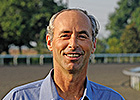By Lenny Shulman

(Originally published in the July 17, 2010 issue of The
Blood-Horse magazine. Feel free to share your own thoughts and
opinions at
the bottom of the column.)
With the year’s initial sale of yearlings in the rearview mirror, what do we make of the Thoroughbred industry’s journey along Recession Road?
After the Fasig-Tipton Kentucky July sale delivered numbers that represented shallow drops in gross, average, and median, and improvement in the buy-back rate, is the glass half-full or half-empty?
Truth be told, many are happy there’s still fluid in the container.
That breeze you feel against your sunscreen is the collective sigh of relief that the Fasig-Tipton sale averted having the bottom drop out of the market. No one would argue that this year’s modest drops represent anything close to turning the corner—remember, the Dow Jones Industrial Average sits nearly 2,000 points higher than it did during the sale last year—but at least the cloak of stability draping the market, however uneasily, means that players can heal their wounds and fight another year, a year that will reflect lower production costs due to the stud fee depression that began in 2008.
Make no mistake, though. This will be a smaller industry going forward. The damage for many has already been done, either through reduced revenue streams or less friendly bankers. Satish Sanan, an owner, breeder, and industry activist, told us recently he believes 42% of the farms in New York, Florida, and Kentucky will soon be out of business. Mediocre sale numbers will not save everyone.
“We were satisfied the (July sale) results were solid without being spectacular,” summarized Fasig-Tipton chief operating officer Dan Pride. “Our clients who sell 2-year-olds reinvested from their business last spring, and for those that need to sell yearlings, there is still demand.”
There are several ways to shade the July sale’s results toward the sunny side of the street. For one, batting lead off in troubled times can be a difficult position. Buyers aren’t necessarily in a big hurry to write checks unless they’ve absolutely fallen in love, and many would rather wait for the wider selection of products they can examine on the September shelves. Also, the July auction’s emphasis on first-year sires doesn’t play nearly as well in a down market, when investors tend to gravitate toward blue chips, making unproven commodities a much tougher sell. Combine those elements with the fact that Sheikh Mohammed, the world’s most prolific buyer of bloodstock, bought three head this year for $820,000 compared to five lots worth $1.55 million a year ago, and the modest downturn doesn’t seem all that bad a performance.
It was the improved buy-back rate, from 36.8% a year ago to 28.7%, that may well prove the most important statistic coming out of July.
“The increase in the clearance rate was a minor victory,” noted Pride. “Getting a depth of buyers throughout the whole yearling sales year is a major focus of ours, so that was encouraging.”
The buy-back rate was helped after the sale, as well. Consignors such as Bret Jones of Airdrie Stud and John Sikura of Hill ‘n’ Dale Farms noted they completed sales privately subsequent to lots failing to meet their reserve in the ring. Both were satisfied with their results at Fasig-Tipton, with Airdrie selling the second-highest-priced yearling in the sale, and Hill ‘n’ Dale getting its inventory moved to new homes.
And that, in this environment, is the name of the game.
“We’re all looking for trade,” noted Keeneland director of sales Geoffrey Russell, “and what I take away from this is that there is trade taking place in our industry. That in itself will represent a success this year. So the buy-back rate being down is, I think, a very positive thing.
“I’m not sure any trend was established. (Fasig-Tipton) Saratoga will give us a look at where we are at the upper end. But until the (Keeneland) September sale, we really won’t know. If every sale for the remainder of the year can do what the July sale did, there will be happy people in the business. This is a year to buckle down and get through and hope to be around next year to sell again.”
So, while everyone likes to dream of home runs, this moment might be better served concentrating on base hits and, if it can be afforded, patience. As the 18th-century wordsmith Oliver Goldsmith wrote, borrowing heavily from the 15th-century’s Desiderius Erasmus, “For he who fights and runs away/May live to fight another day;/But he who is in battle slain/Can never rise and fight again.”




